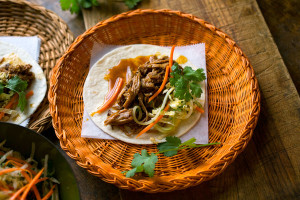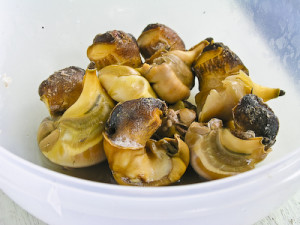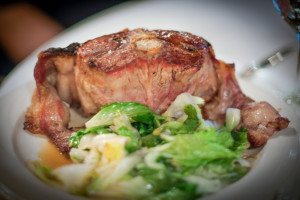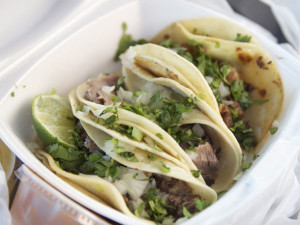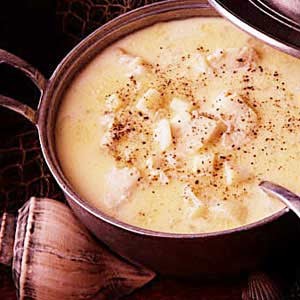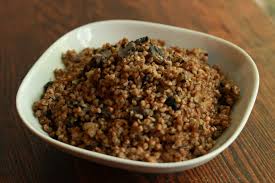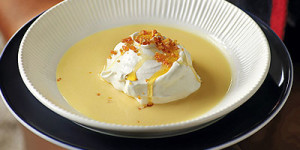The temperature in HG/BSK’s New Mexico neighborhood has been in the low thirties lately. This may seem like tropical weather to those unfortunate folks who live in the Northeast but it seems frigid for the fortunate residents of The Land of Enchantment. That means comfort food for dinner. HG/BSK had a busy day so didn’t want to spend too much time in the kitchen. Sam Sifton’s New York Times recipe for “Vaguely Vietnamese Slow Cooker Pork Tacos” seemed like a good idea. Dusted off the slow cooker (haven’t used it in some time). The pork butt was popped into the slow cooker with the hoisin-fish sauce-ginger-garlic-onion-sesame oil mixture. Began cooking at 12:30. Turned off cooker at seven PM. BSK made a great cole slaw suggested by Sifton (This is a keeper. Perfect with any Asian food). Warmed flour tortillas. Pulled apart the tender and juicy pork. Ladled pork on the tortillas (with a few sprigs of cilantro). A great dinner. HG put a scallion and some dashes of Frank’s Louisiana Hot Sauce Ketchup in HG’s soft taco. The appetizing slow cooked pork can be utilized in a number of ways. HG intends to eat the pork tucked into some endive and romaine leaves. Should be good as a topping for room temperature sesame oil-slicked cellophane noodles with bean sprouts and chopped scallions. Looks like the HG/BSK slow cooker won’t be collecting dust anymore.
Porky Slow Cooked Pleasure
March 9th, 2015 § 0 comments § permalink
Scungilli
February 27th, 2015 § 0 comments § permalink
The dictionary defines scungilli as “a large marine whelk or conch eaten as food.” Yes, this was a protein–in the form of salad or mixed with pasta smothered in super-hot red sauce–that was served in many old fashioned New York Italian restaurants during HG’s youth. The sea creature was pronounced “skoonjeel” and was delicious. Scungilli mostly disappeared from Manhattan menus and soon could be found in only two restaurants in Little Italy–traditional Vincent’s and upstart Umberto’s. In HG’s opinion the best fiery scungilli pasta dishes were found in a tiny Italian joint in Chinatown (corner Mott and Pell). HG ate there with two rugged Goodfellas who solicited HG’s promotional advice on how to improve sales at their legitimate front –a Staten Island furniture store. (Of course, scungilli was always available in Brooklyn, the Corona and Howard Beach neighborhoods of Queens and in the beloved Belmont Tavern, Belleville, New Jersey). Scungilli had its big moment of fame when gangster Crazy Joe Gallo was murdered at Umberto’s Clam House on April 7, 1972. (Scungilli, presumably, was on the table when he met his end.) Crime analysts have wondered why Gallo was dining at Umberto’s rather than the more traditional Vincent’s. HG has a theory: Joe was sentimental and his father, also a gangster, was named “Umberto.” Recently, a hungrygerald.com follower informed HG that there’s a very good Italian scungilli restaurant in Vero Beach, Florida. HG will keep it in mind if he ever ventures into Jeb Bush territory.
Mutton Chops
February 24th, 2015 § 0 comments § permalink
If you are a happy carnivore with a taste for robust red meat, there is nothing better than a big, rare mutton chop. Oddly, it is not a celebrated menu item in New York or Paris. (If you search, you can find mutton chops in London). In times past you could find mutton chops at two locations in New York: Keens Chophouse on W. 30th Street and at Gage & Tollner on Downtown Brooklyn’s Fulton Street. Gage & Tollner was founded in 1878 (closed in the 1990’s) and had a mellow antique interior with 38 gas lamps, wood paneling and mahogany tables. The mutton chop was medium in size and served with corn fritters sweetened with a bit of maple syrup. (The combination seemed unusual but it worked). Thankfully, Keens is still in business and their legendary mutton chop is still giant. Prices however are a different story: In keeping with present day oligarchy-influenced New York the chop now fetches $51.00. HG/BSK enjoyed Keens often when they lived on the Upper West Side during the 1960’s.(Prices were much more modest then). Once, during a Boston-type blizzard, HG/BSK ventured out at night, found an intrepid cab, and supped on Keens’ mutton chop, skillet sized golden hash browns and wine. Only two tables in the restaurant were occupied. Keens (founded in 1885) was not only a cold weather choice. On a blazing July day, HG/BSK shopped for baby furniture at Macy’s (baby daughter Lesley was due in August). HG and very pregnant BSK left summer heat behind and had an early dinner of roast beef, fiery horseradish and Yorkshire Pudding at Keens. The beautifully aged restaurant interior was cooled by very modern air conditioners. HG/BSK felt they were dining in late autumn London. Keens now charges $58.00 for its prime rib.
Viva Mexico
February 23rd, 2015 § 0 comments § permalink
In the early days of television (1954) HG and a colleague recently arrived in New York from California, wrote TV news programs that were broadcast nationally. The news was illustrated with still photos (they were called “telops”) which were transmitted by telephone wire to the TV stations (news film was introduced at a later date). HG and his pal were swift and nimble news writers and photo selectors. It was fun. International News Service, the Hearst wire service (later absorbed by United Press) was HG’s employer. INS was housed in the Daily Mirror building on E. 45th Street and HG usually lunched in the hole-in-the-wall Greek diner off the building’s lobby. But, knowing that his California buddy missed Mexican food, HG invited him to lunch at Manhattan’s only Mexican restaurant, Xochitl. A mistake. “This is a bad joke,” he declared in reference to both the food and the high price of lunch. In the 1960’s HG/BSK visited friends in California (their first trip to the state) and were determined to eat “real” Mexican food. Their friends (not foodies) took them to a nearby Taco Bell (then only in California). HG/BSK found it satisfactory but felt there was something missing. HG thought about all of this at a Sopaipilla Factory dinner last night (the eatery is in Pojoaque, New Mexico, a few minutes from HG/BSK’s home). HG/BSK and their visiting eight-year-old grandson, Haru, feasted on menudo, enchiladas, green and red chile of a quality simply unimaginable to a New Yorker of the 1960s. Not so to present-day New Yorkers like grandson Haru, who knocked off a bunch of chicken tacos declaring them to be “awesome” with the caveat that, as a Brooklyn guy who regularly dines in Sunset Park (a Mexican neighborhood near his home), he has devoured many an authentic taco. In fact New York is having such a Mexican food renaissance (with both high end and low down options) that HG’s Californian pal would probably find much to smile about. As part of this renaissance, HG is looking forward to next month’s opening of Rosie’s, Restaurateur Daughter Victoria’s next New York restaurant. This will feature farm-to-table Mexican cooking. (Husband/chef Marc Meyer has just returned from a two-week visit in Mexico with Diane Kennedy, the ultimate authority on Mexican cuisine). Meanwhile, HG will be off to nearby El Parasol to give visiting Haru another taco fix.
The Evolution of Japanese Dining In New York
February 21st, 2015 § 3 comments § permalink
The first time HG ever dined in a Japanese restaurant was in 1958. The restaurant was Suehiro, a tiny room near Columbia University. It was one of two Japanese restaurants in New York (the other was in the East 20’s). There were no sushi or ramen eateries in this very cosmopolitan city. HG’s Suehiro meal consisted of miso soup (with some tiny cubes of tofu), beef sukiyaki cooked table side in an electric pan by a kimono clad waitperson. Sliced orange for dessert. A pot of hot green tea. The check was laughably small and the satisfaction was great. HG was hooked. Never tasted sushi until the 1960’s when the first sushi bar opened in the West 40’s. First taste didn’t impress. But, subsequent visits made HG a raw fish convert. Now, of course, New York has scores of Japanese restaurants specializing in everything from fried chicken to curry to traditional Japanese pub food. The choices for sushi and ramen are limitless — from small dive joints to $800 omakase feasts at one of the city’s most exclusive sushi emporiums. HG is bemused at the fact that Japanese restaurants now vastly outnumber Jewish delicatessens (there are less than ten) in Manhattan. HG/BSK delighted in the food they consumed in Tokyo and Osaka (HG/BSK were in Japan some ten years ago for the marriage of SJ and Exquisite Maiko). SJ and EM guided HG/BSK through the vast food markets in the two cities. There were visits to a delightful sake bar and stops for grilled chicken and pork, fried balls of chopped octopus and much more. Slurped a lot of memorable ramen. One of the benefits of having a Japanese daughter-in-law (besides her production with assistance of SJ of Haru and Teru, HG/BSK’s wonderful grandkids) is cuisine. EM is HG/BSK’s favorite cook. As HG has noted in many posts, EM produces the world’s best tempura, robust stews and soups and life enhancing seafood. Her meals at SJ/EM’s Brooklyn home or in the family Prince Edward Island ocean front paradise are among life’s most joyous occasions.
Smoky Fish Chowder
February 19th, 2015 § 3 comments § permalink
There are few things more warming and comforting on a cold winter night than a big, steaming bowl of smoky fish chowder. The temperature dipped downward last night. There was a light dusting of snow. Logs blazed in the fireplace. Yo Yo Ma’s musical magic (some unaccompanied Bach cello compositions) poured out of the Bose. Candles flickered on the table. And, of course, to make this tableau of New Mexico winter magic complete, there was smoky fish chowder. Here’s how BSK makes the dish. Thick slices of peppered bacon are fried until crisp. Removed. Some bacon fat is left in the pan and butter is added. Chopped onions are cooked until softened. Dusted with hot, smoked Spanish paprika. White wine goes into the pan, whole milk, a sprig of thyme and chunks of Yukon Gold potatoes — all to be enveloped in the folds of some nice fish stock. Cooked until potatoes soften. At that moment, BSK tosses in two dozen scrubbed little neck clams in their shells. As they begin to open, a pound of Icelandic cod is added and cooked for about four minutes. The thyme is removed, crisp bits of bacon are sprinkled over the dish. Some pats of butter are popped in to add golden tones. Saltine crackers and a bottle of red Rioja complete the meal. The result is warm contentment.
Eat Your Vegetables!
February 17th, 2015 § 0 comments § permalink
Yes, that’s been the strident order of Moms for generations. Rebellious little HG bypassed vegetables (except for hidden treasures — little mounds of buttery mashed potatoes enclosing spinach). These days, because of BSK’s wizardry, HG is a vegetable lover. Here are some BSK specialties: Haricot verts cooked to the nice midpoint between Paris bistro soggy and health addict raw. Snow pea pods stir fried with ginger and garlic. Fried chopped zucchini and peppers plus corn kernels (best accompaniment for Adobo dusted pan fried pork chops). Thanksgiving-style roast brussels sprouts with chestnuts. This is just a sampling. BSK outdid herself last week with two surprising vegetable dishes. BSK followed Sam Sifton’s New York Times recipe for rotisserie-style Greek chicken (BSK showered the crispy chicken slices with feta cheese, kalamata olives and chopped parsley). The surprise was in the salad which augmented the chicken. Inspired by the Ottolenghi cookbook, “Jerusalem,” BSK roasted olive oil gilded cauliflower nuggets. Mixed them with chopped celery, pomegranate seeds and walnuts. Dressed them with a mix of olive oil, lemon juice, cinnamon and maple syrup (that’s right, maple syrup). A wow. This was followed by a dessert of nut brownies slicked with peanut butter icing prepared by dinner guest Karen K., neighbor, movie producer and New Mexico Dessert Queen. BSK’s next triumph was based on brussels sprouts. (BSK long ago banished HG’s antipathy toward “fairy cabbages”). BSK sautéed quartered sprouts in olive oil with garlic and thin shallot slices. Added chicken stock and cooked until the sprouts were barely tender. Tossed in some almost done penne. Continued cooking a few more minutes. When done, BSK added a goodly amount of parmesan, shredded sage leaves and a generous half pound of crisply fried thick cut preservative free bacon. A shower of Aleppo pepper. The result: A supreme pasta dish.
More Kasha Love
February 14th, 2015 § 2 comments § permalink
Kasha (also known as buckwheat groats) is one of HG’s favorite foods. HG is always puzzled why it’s so seldom on restaurant menus (except for the rapidly diminishing number of Jewish “dairy” restaurants) and is so rarely used in home cooking. Simple to make. The kasha grains are mixed with beaten egg and sautéed until dried. A few cups of chicken broth are added to the saucepan and the mix is cooked until the grains become soft (Warning: Never overcook into a mush). HG likes kasha topped with fried onions and mushrooms (accompanied by a bowl of sour cream and plenty of ground pepper and sea salt flakes). Great topped with fried chicken livers and onions. Kasha Varnishkes used to be a staple in traditional Jewish eateries. In these kosher (non dairy) restaurants the mix of kasha and butterfly (farfalle) pasta would get an exhilarating hit of crisp fried onions and a big dollop of chicken fat. A young HG would accompany this treat with plenty of cold vodka and beer at Moe Dubiner’s eponymous non-kosher restaurant (long closed) on New York’s Stanton Street. It was a big favorite of the Jewish gangsters and gamblers who came to the restaurant for a late night snack. Kasha is versatile. Great in a big bowl of steaming chicken broth. Excellent as a filling in traditional blintzes (an egg crepe topped with kasha, rolled and then fried gently) or knishes (a flaky stuffed pastry). Best of all as an accompaniment to slow roasted beef brisket. Obligatory is lots and lots of savory gravy.
The Knish
February 12th, 2015 § 0 comments § permalink
The Knish is an Eastern European street food introduced to the United States by turn of the century Jewish immigrants from Belorussia. The Knish is a flaky pastry filled with a variety of stuffings—potato, kasha (buckwheat groats), spinach, cheese. A famous name in knishes (and loan-sharking…but that is another story) is Yonah Schimmel. Yonah began selling knishes from a pushcart on New York’s Lower East Side in 1890. The Yonah Schimmel knish bakery has been at its present location on East Houston Street since 1910. (There seems to be a spelling confusion. The big sign on the store says “Yonah Shimmel” even though the correct spelling is “Schimmel.”) Another top knish baker (alas, departed) on the Lower East Side was a woman named Gussie Schwebel who ran an eponymous knishery near Schimmel’s on Houston Street. Gussie was a flamboyant self promoter with a flair for publicity. In 1942, she wrote a letter to First Lady Eleanor Roosevelt in which she volunteered to bake knishes for our brave soldiers overseas. The suggested pastries would provide needed nourishment. She followed that up with another letter offering to deliver a sampling of hot knishes to the Roosevelt town house on E. 65th Street. Mrs. Roosevelt accepted the offer and the Jewish Daily Forward newspaper ran a front page story headlined: “Mrs. Roosevelt To Taste Jewish Knishes.” When delivery day arrived the Roosevelt home was surrounded by reporters, cameramen and a curious crowd. Canny Gussie Schwebel (or her press agent) had tipped off the newspapers. Mrs. Roosevelt, who didn’t enjoy being the target of press agentry, refused the knishes. Thus, the U.S. military had to fight World War Two without the benefit of nourishing knishes. (The information about Gussie Schwebel and Eleanor Roosevelt is from Laura Silver’s invaluable,researched book: “Knish: In Search of the Jewish Soul Food”. Published by Brandeis. The link is http.// www. knish.me).The knish, long only found in New York City, is making a modest comeback. Knish bakeries have opened in Los Angeles and a few other cities. Zabar’s (on New York’s Upper West Side) bakes knishes and sells them online. Gabila’s (located in Copiague, L.I.) is a mass producer of knishes who claim to have sold over a billion. HG has never fancied knishes. HG was spoiled by his Mom’s incomparable cheese (potato or kasha) blintzes served from a hot frying pan placed on the dining room trivet. Accompanied by a big bowl of rich sour cream. Ah!!!
Neighborly Feast
February 8th, 2015 § 2 comments § permalink
Neighbors got together for a celebratory feast. The place: The beautiful home of Polly B. and David F., a talented, life enhancing couple. Their big kitchen-dining-living room is everyone’s fantasy of Santa Fe. Antique beams and thick adobe walls. A monumental kiva fireplace containing an abundance of blazing logs. Well lit and meticulously placed works of art. The celebration: Polly B., a noteworthy photographer, has faced (with bravery and good humor) eye surgery. Success at last. The beautiful woman can see. An unflattering eye patch has been removed. Good reason to eat, drink and laugh a lot. Present at the celebration were two of Polly’s three daughters, Jennifer (who lives in Beijing) and Leslie (who lives in Washington and Cape Breton Island) plus neighbor Karen K., the film producer who has been dubbed The Dessert Queen by HG because of her genius at crafting sweet things. HG/BSK brought appetizers of chilled prawns (with remoulade sauce) and a spread of smoked salmon. Polly’s daughters grilled salmon and accompanied the moist and flavorful fish with a tangy red pepper sauce, an unusual mushroom risotto and a nicely dressed green salad. There was a good, warmed baguette and a lush cheese course. Needless to say, much Pinot Grigio and Cabernet was drunk (preceded by potato vodka). The feast concluded with Karen K.’s Ile Flottante, HG/BSK’s favorite dessert. Karen K.lived up to her royal soubriquet. Well, that’s life with HG/BSK’s New Mexico neighbors. So, what do your neighbors do (besides playing loud music and arguing loudly) ?
